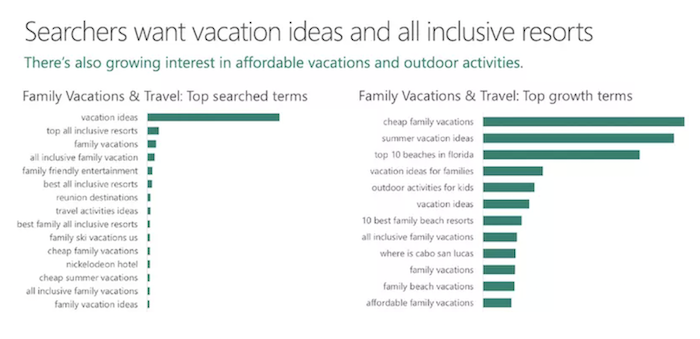
How to Target Tourists Through Paid Ads
The tourism industry is rich and exciting, full of cultural knowledge, shared experiences, and career-building opportunities for marketers.
It’s true. The tourism industry we know today was largely created by advertisers. Before the 1920s, travel was a luxury only available to the wealthy. However, with the introduction of paid vacation time in the 1930s, travel became part of regular American life.
Advertisers were quick to jump on this trend, and Americans began seeing tourist ads show up in their favorite print magazines and newspapers, making travel one of the most sought-after experiences of modern life.
These days, travel is more widely available than ever before. With high-speed trains, planes, and boats, you can travel anywhere in the world in a day’s time.
However, modern consumers aren’t looking in print magazines to find travel inspiration. These days, if you want to talk to your biggest customers, you need to do it online.
10 Ways to Target Tourists With Paid Ads
Creating high-performing tourist ads is not always as easy as it seems. Of course, beautiful beaches and breathtaking views catch people’s attention, but it takes more than pretty pictures to win them over completely.
What’s more, competition in this space is higher than ever before. If you want to outperform your competitors, you need to stand out.
1. Use Geographic Targeting
The tricky part about creating great tourist ads is that your target audience is often worldwide.
You could serve ads to every country in the world, but that’s going to eat up a lot of your budget.
Instead, try delivering your ads to specific locations where you know similar audiences are likely to be. This is called geographic targeting, and it helps you define where your ads will be seen to maximize your marketing budget.
For example, you can target other tourism sites in your city or country to grab the attention of tourists already in your area. Or, you could even set a larger radius to encourage people driving by who may not know about your destination just yet.
It’s also good to remember that while you can target your tourist ads to specific places, you can exclude locations you know your target audience won’t be as well. For example, you may not want to target the local university on summer break as most students won’t be there.

Discover the Palm Beaches in Florida used this technique in their impressive “Friends Trust Friends” campaign.
By targeting a 30-mile radius around the town of Royal Palm Beach, they targeted both locals and residents, alongside a lucrative out-of-market tourist market. This results in a 23-percent increase in overnight stays for the brand.

2. Target Certain Interests
Another way to accurately send ads to your target market is to focus on user interests rather than location.
This can help you show ads to people who are already interested in similar experiences or services you may be offering.
For example, if you run a surf hut on the beach, it would make sense to serve ads to people who are interested in surfing.
If you’re using Facebook ads, you can do this easily by typing in relevant interests in the provided field.

Traverse City Tourism leveraged this technique to bolster their off-season tourism traffic.
They used Facebook ads to promote their cherry blossom blooms by targeting users visiting pages about cherry blossoms. They also created lookalike audiences to maximize their reach.
This excellent campaign, created by TwoSix Digital, brought 319,000+ impressions and doubled their average click-through rate.

3. Offer Sales
It’s always a good idea to offer discounts, package deals, and sales within your tourism ads.
Every month, millions of people search for travel-related keywords on tools like Ubersuggest.
The biggest trend in their searches? People are looking for inspirational vacation ideas and affordable deals, according to Bing and cited by Search Engine Journal.

That means you need to give the people what they want.
Serving special offers, family vacation bundles, and flash sales can be a huge incentive to prospective travelers trying to figure out their next vacation.
What’s more, discounts and deals are a great way to introduce your offerings to new audiences and hopefully retain more loyal customers.
Just remember, discounts and deals have a downside, too.
Loyal customers have a better proven ROI than new customers. While you might spend $5,000 to acquire a new customer, you may only need to spend $200 to keep one you already have.
Deliver your discounts at a reasonable rate, and make sure you’re targeting the right audiences to ensure your budget is spent wisely.
4. Anticipate Their Questions
Great customer service starts with an in-depth knowledge of your customers’ wants and needs.
To deliver a truly exciting experience that will improve your customer retention, you need to anticipate customer questions and include that information in your tourist ads.
For example, a hotel might promote free Wi-Fi or complimentary breakfast options, knowing that this will incentivize customers to choose your spot over another.
You can advertise convenience features as well, such as close to transit, walkable, or included in city sightseeing passes.

.
5. Use Images and Video
Tourism is all about the experience, and what better way to showcase your unique offering than with engaging video and photo assets.
Visual content in marketing campaigns can help you connect with your audience and help them imagine what it’s like to visit your location.
You can use photo, video, and graphic elements within your tourist ads to deliver this messaging.
When using videos and images in your tourist ads, make sure they are contextually clear. Don’t post a photo of a waterfall if you are advertising a kayak trip. Similarly, if your tourist ad contains a video of a white-sand beach, be sure to include details on your hotel or service to attract the most qualified leads.
What’s more, many brands have seen success by experimenting with dynamic visual content.
For example, Travel Alberta used a 360-degree video in their Facebook ads to create interactive, immersive experiences for users.
By interacting with the ad, users could explore fossils in historic Drumheller in Canada. They could even click around in each scene to explore further into the caves.
According to Crowd Riff, these tourist ads resulted in 130,000 views for Travel Alberta, along with 600 shares and 300 comments from users who loved the campaign.

6. Research Your Past Guests to Target a Specific Audience
Market research is essential if you want to read your audience’s mind.
If you want to create truly effective tourist ads, you need to understand who your past guests are, what brought them to you, and how you can get more guests like them in the future.
For example, if you know most of your guests come from small towns on the West Coast, you can use that information to target that area.
Similarly, if you find yourself seeing an influx of visitors from neighboring towns, it may be worth localizing your marketing to attract those customers better.
This research will help you develop an idea of what a common guest might look like. From there, you can target a highly specific and relevant audience.
7. Take Advantage of Remarketing
As we discussed before, the best customers are repeat customers because they cost less to keep and allow you to better predict your profits going forward.
According to research by Frederick Reichheld of Bain & Company, increasing customer retention rates by five percent can increase your profits by 25 percent%. That’s a metric worth aiming for!
How can you get more long-term customers and maximize your marketing budget when creating tourist ads?
The secret is to invest in remarketing campaigns. This will allow you to target people who have already shown interest in your service or location and give you an opportunity to bring them back to your business.
When doing remarketing for tourist ads, be sure to do your research. Most tourists visit many websites to compare and check prices.
If you see a customer returning to your website over and over again, it may be a good time to serve them a discount option or promote your complimentary services.
You can also target customers who completed specific actions, such as buying a tour pass or signing up to your mailing list.
Remarketing strategies can help increase your conversions and sales, alongside creating a stronger roster of repeat customers.
8. Leverage User-Generated Content
User-generated content (UGC) can help you get more shares, likes, and engagement from your audience by leveraging their influential power.
In tourist ads, user-generated campaigns are a great way to spread your brand’s message to interested audiences.
People love to post photos and videos of their travels, so why not use that trend to your advantage? What’s more, it’s a cost-effective method of advertising that won’t break your budget.
A UGC campaign for a tourist ad might look like offering discounts or incentives to users who post about your business. If you’re a restaurant, this might look like discounts on a bill for users who post a photo of a specific food item. If you’re a hotel, you can offer users complimentary services if they check in on social media.
You can also use these UGC materials on your website to show potential tourists what their experience could look like.
Visit Duluth used this tactic in their Summer Guide to Duluth campaign, where real-time photos and videos of tourists were displayed in a UGC gallery on their website.

9. Direct Traffic to Landing Pages
It’s important to lead your tourist ads toward your website or other lead conversion points to direct them to points of sale.
Creative landing pages are a great way to customize your user journeys and improve the performance of your tourist ads. Landing pages give you extra opportunities to communicate your unique selling points, such as complimentary services, licenses, or nearby experiences.
Visit Indy put their landing pages to work in a creative tourist ad campaign where they used video content and persona-specific landing pages to engage users. For instance, their “foodie” persona was directed to a landing page that displayed “Things Every Foodie Should Do in Indy.”
The results were a three-times increase in click-through-rates and a more optimized budget for the brand.

10. Make Use of Bing
Travel and tourism are a global phenomena, so don’t get stuck relying on only one search engine to help your campaigns.
Bing is widely used by global audiences, especially when it comes to travel.
Setting up Bing ad campaigns is often cheaper than ads on Google. While the performance metrics aren’t as high, it is worth investing a small budget into Bing so you don’t miss out on any new audiences.
Also, since competition on Google can be high, Bing gives an opportunity to outperform your competitors when creating tourist ads. According to Spinutech, Bing budgets can be 20-35 percent lower than traditional AdWords budgets.

Conclusion
As more and more people search for vacations, experiences, and deals online, the importance of strategic tourism marketing will only grow.
Successful tourist ads leverage all aspects of your conversion funnel in order to best engage with your varied audiences. Audience targeting, visual content, remarketing, landing pages, and user-generated content can help you attract audiences from around the world to your destination.
From there, it’s all about delivering unique and exciting customer experiences to keep your customers coming back year after year.
What other marketing tactics have you used in tourism advertising?
The post How to Target Tourists Through Paid Ads appeared first on Neil Patel.
























